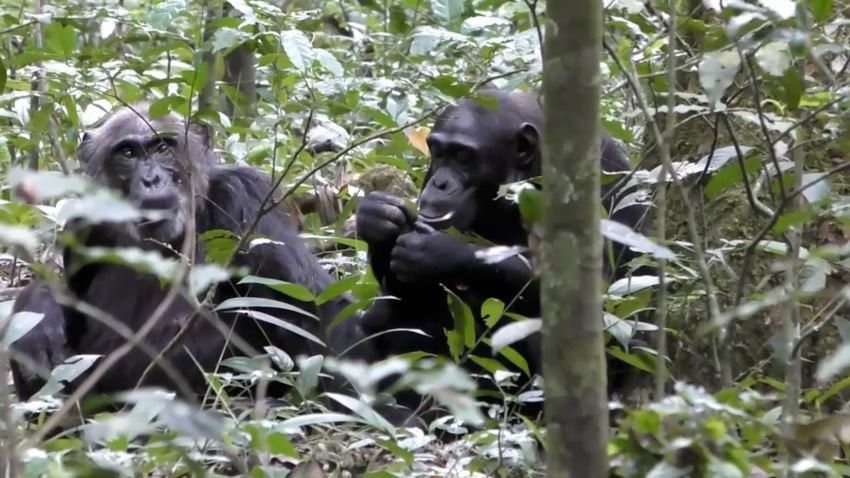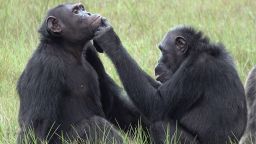Sign up for CNN’s Wonder Theory science newsletter. Explore the universe with news on fascinating discoveries, scientific advancements and more.
A chimpanzee doesn’t hesitate to make it clear when it wants attention. The closest cousin of humans, this species of great ape has effective ways of communicating what it needs.
Researchers have often observed captive chimps pointing to an object they want their caregivers to give them or young chimps in the wild having tantrums to get attention from their mother.
Until now, these behaviors have only been observed when a chimpanzee wants something. Recently, however, scientists documented footage of a wild adult chimpanzee showing her mother a leaf, apparently just to share the experience with her, according to a study published Monday in the journal PNAS.
More examples of such interactions are needed to better understand the intention behind the gesture, the study’s researchers said, but the observation could demonstrate chimpanzees possess a social behavior once thought to be specific only to their human relatives.
“Critically, she didn’t seem to want her mom to do anything with the leaf. … She seems to be showing it just for the sake of showing it. It’s like, ‘look, look, this is cool, isn’t it?’ And that is very humanlike and something that we thought was fairly unique to our species,” said study coauthor Katie Slocombe, a professor of psychology at the University of York in the United Kingdom.
The mother-daughter chimps, called Sutherland and Fiona by researchers, are part of the Ngogo chimpanzee community in Kibale National Park in Uganda. Slocombe and her colleagues were studying Fiona and her infant as part of a separate project on their wider social group, when they captured the footage of Fiona holding the leaf out to her mother before taking it back again once she had Sutherland’s attention.
“This is the first promising kind of suggestion that this (behavior) might not be uniquely human, and that chimpanzees might be capable and motivated to do this,” Slocombe said.
Show-and-tell
Fiona had been engaged in what researchers call “leaf grooming,” a common behavior in which a chimpanzee will stroke and manipulate a leaf. The reasoning behind the behavior is a mystery, but Slocombe and her colleagues suspect it could be to inspect an ectoparasite, such as a tick, on top of the leaf. Often, surrounding chimpanzees will also become engrossed in the action, intently watching the leaf being groomed.
“When Fiona was doing this, (Sutherland) didn’t really seem interested; she wasn’t watching and wasn’t giving her any attention. Fiona is then showing her the leaf to say, ‘look at it,’” Slocombe said. “She is really persistent with trying to get her mom to look at it, and it’s only when her mom really visibly dropped her whole head to orient to the leaf that (Fiona) then seems satisfied.”
The researchers examined 84 video clips of chimpanzees grooming leaves near at least one other individual to search for possible explanations for the divergence from typically observed behavior. The sample had a wide age range, with male and female chimps observed.
In over 75% of the cases, another individual had either approached the leaf groomer or had watched very closely, the study team found. The vast majority of the clips showed that leaf grooming did not initiate social activity — such as grooming one another, playing together or even eating the leaf — during or following the action, which caused the researchers to believe Fiona was simply looking to share an experience with another ape.
“Human infants, from about 10 months of age, will start to bring things that they find interesting to their caregivers. … Very much like Fiona did, they will extend their arm with the object in their hand out toward the face of their caregiver. If the caregiver doesn’t react, they’ll readjust and they’ll persist until the caregiver looks at it,” Slocombe said.
Slocombe and her team always maintain a 23-foot (7-meter) distance when observing the chimpanzees in the wild, so as to not disturb them. This standard practice rules out the possibility that the behavior was learned from humans.
“Chimpanzees have been observed to place ectoparasites, found while grooming, on leaves and try then to smash them. In the clip, I can’t tell whether this is the case, but Fiona seems to take (something) out of her mouth and then places it on the leaf and ‘shows’ it to her mother,” said Simone Pika, head of the research group Comparative BioCognition at the University of Osnabrück in Germany.
Pika was not involved with the work, but her team also observes chimpanzees in Ngogo and plans to continue to look for further evidence and clarification.
“We are still at the beginning to fully understand the communicative complexity of chimpanzees and the implications for the evolution of human language and cognition,” Pika said. “We need much more data to clearly evaluate whether indeed chimpanzees in the wild use declarative gestures and what the function is.”
This study is the first documented observation of this behavior in the wild to suggest apes have a motivation to share experiences with one another, Slocombe said. She hopes it will encourage those who work with chimpanzees, in the wild or in captivity, to look out for more examples.
“What I’m really hopeful of is that the publication of this result will kind of catalyze other people who studied chimps for a long time, maybe that have loads of video footage of them, to think, ‘Oh, hang on. I’ve seen chimps do something like that before, but I just didn’t really think it was significant,’” Slocombe said.
“Maybe then, we can actually start to get multiple examples to really better test whether the motivation of the chimps is similar to humans.”




